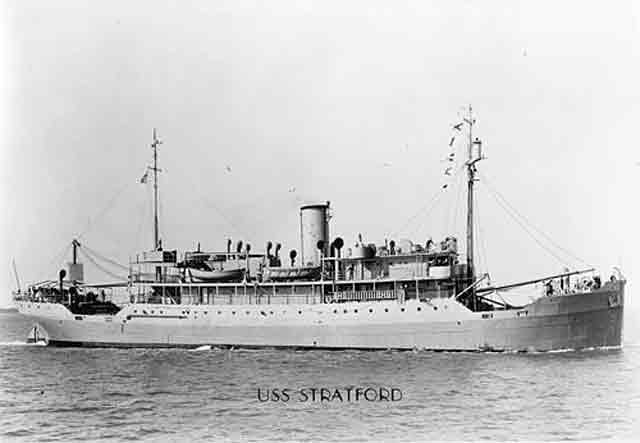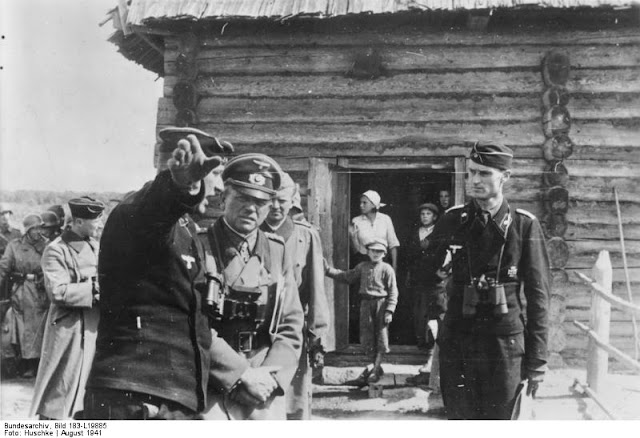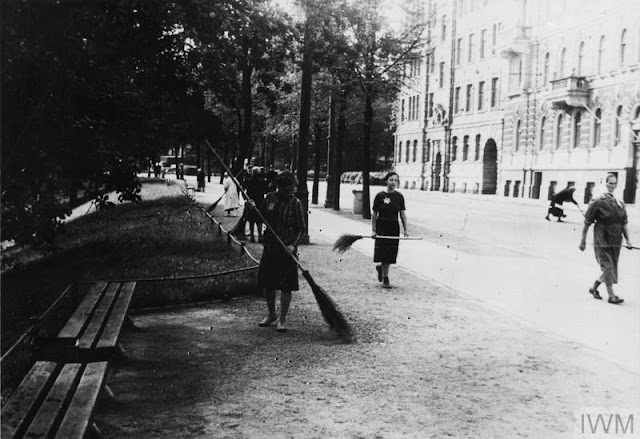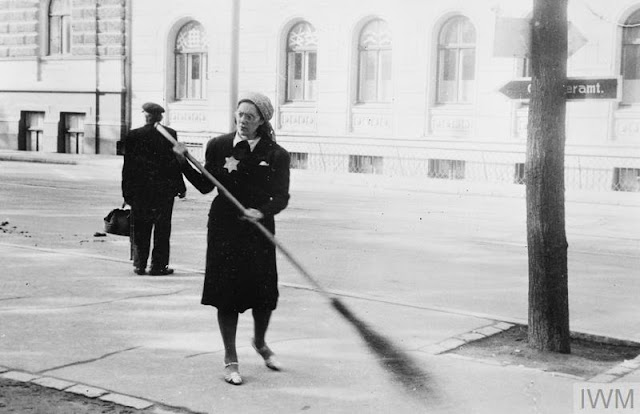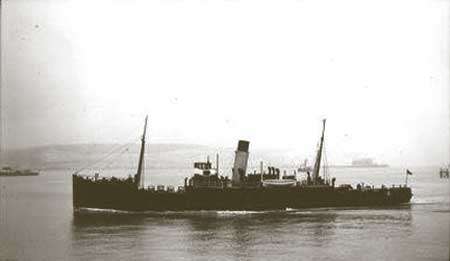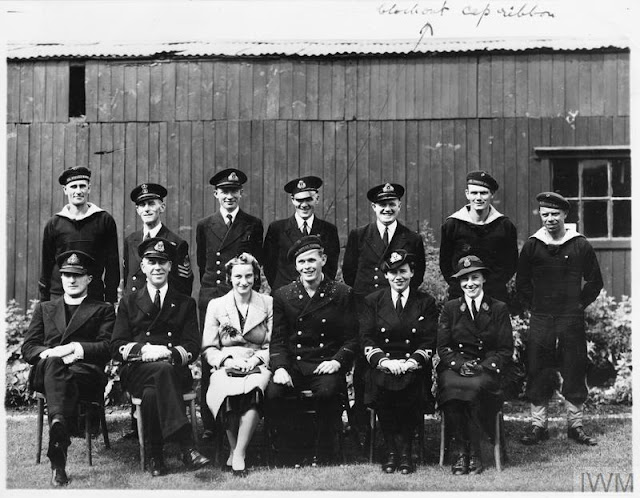Wednesday 6 August 1941
 |
| Hitler and Antonescu at the afternoon Fuehrer conference at Army Group South headquarters, 6 August 1941. Note that Antonescu is sporting his new Knight's Cross. |
Eastern Front: The German high command as of
6 August 1941 has been compiling statistics on losses on the Eastern Front, and today divulges some of its findings. According to reports from the front, the Wehrmacht has taken 266,352 casualties on the Eastern Front since the beginning of Operation Barbarossa. This is compared to 895,000 prisoners taken and an unknown number of Soviet casualties. While it is generally accepted that the Red Army takes higher casualties than the Wehrmacht throughout the war, the number of German casualties dwarfs those in earlier campaigns and is making a noticeable impact on the strength of front-line units.
Adolf Hitler, who is visiting the front, has his noon Fuhrer Conference at the headquarters of Army Group South. At the instigation of General Franz Halder, OKH Chief of Staff, Field Marshal Gerd von Rundstedt, commander of Army Group South, advocates orienting the entire Eastern Front attack toward capturing Moscow. Halder (who does not attend the meeting) writes in his war diary:
The Fuehrer again showed himself absolutely deaf to these arguments. He still harps on his old themes: 1) Leningrad... and 2) Eastern Ukraine... 3) Moscow comes last.
Hitler makes clear his priorities at the conference when he praises the advance of Panzer Group 1 on Kryvyi Rih, which has "high-grade iron-ore deposits and the large blast furnaces." The difference between Hitler and the generals comes down Hitler's planning for a long war which will require economic exploitation, while the generals seek a quick knockout of the Soviet Union. Neither solution necessarily is right or wrong, but the Wehrmacht is built more for short, sharp campaigns than a lengthy war of economic production and attrition.
In the Far North sector, the Finnish 7th Division of the VII Corps continues its advance from Sortavala to the shore of Lake Ladoga at Lahdenpohja. Further north, Group J of Finnish III Corps advances rapidly toward Kestenga despite bitter Soviet opposition. The Soviets are trying to rush reinforcements to both areas, but they are remote and there are few available troops nearby. The Stavka calls down 600 headquarters troops of the 14th Army along with a replacement battalion from Murmansk, which does not appear in jeopardy at the moment.
Army of Norway has been calling for help in getting its stalled offensive toward Murmansk rolling again, so OKW sends some reinforcements. The German 6th Destroyer Flotilla and the 12th Antisubmarine Flotilla escort transports carrying the 6th Mountain Division from Stettin, Germany to Kirkenes, Norway.
 |
| Hitler and General Halder, 1940. |
In the Army Group North sector, the German 16th Army takes Staraya Russa (south of Lake Ilmen) and Kholm after a bitter struggle. General Halder at OKH headquarters writes about this, "signs of enemy demoralization (tanks desert to us!)." These stories about enemy desertions crop up throughout the war and never lead to much.
In the Army Group Center sector, the Wehrmacht is juggling units to give some front-line formations a chance to rebuild themselves behind the front. At the lightning-rod position at Yelnya, infantry moves forward to take over positions held by a battered panzer and SS formation. Halder writes in the war diary:
Enemy elements thought to be trapped at Roslavl have escaped. The Russians have an uncanny ability for moving on roads impassable for our troops and build concealed river crossings.
He adds, "Elsewhere, minor attacks."
In the Army Group South sector, the Romanian 4th Army and German 11th Army continue putting pressure on the Soviet defenders of Odesa. Hitler has promised overlordship of the region to Romania if Ion Antonescu can secure it, while the Soviet defenders of the city have been told to defend it to the end. Meanwhile, at Uman, the Germans continue tightening their envelopment of the 100,000 Soviet soldiers trapped there, though the Soviets continue to resist. German 6th Army is almost at the Dniepr River south of Kyiv, while the Soviets score some local successes near Kyiv.
That Soviet morale remains high is demonstrated during an unusual incident over Moscow. The Luftwaffe continues to send raids over the Soviet capital, but they have become small nuisance raids. Red Army pilot Viktor Talalikhin, after running out of ammunition, rams a Heinkel He-111 bomber with his Polikarpov I-16 fighter. Both planes crash, but Talalikhin parachutes safely to the ground.
 |
| Pilots of 5,/JG54 in Russia on 6 August 1941. Shown are Hubert Mutherich, Hans Philipp, Hauptmann Dietrich Hrabak and Lieutenant Josef Puhs. They are standing in front of Hrabak's Bf-109F, which shows 24 victories. Hrabak winds up with 109 victories on the Eastern Front and an additional 16 on the Western Front. |
European Air Operations: During the day, the RAF sends 25 Blenheim bombers on sweeps along the French coast and north of there. The planes all return to base after attacking a few ships.
After a maximum effort on the night of August 5th, the RAF returns to the same three cities - Frankfurt, Mannheim, and Karlsruhe - with smaller follow-up raids after dark. All of the raids target railway yards.
The RAF sends 34 Whitleys and 19 Wellingtons against Frankfurt. The RAF loses 2 Whitleys and 2 Wellingtons.
The RAF sends 38 Welling against Mannheim. All of the planes return.
The RAF attacks Karlsruhe with 38 Hampdens. One aircraft fails to return.
RAF Bomber Command also sends 38 bombers (21 Hampdens, 11 Wellingtons, and 6 Whitleys) against the Calais docks. The bombers have difficulty finding the docks and only 14 are able to drop their bombs over the target. One Hampden fails to return.
One Wellington also is lost on one of two separate Operational Training Units (OTU) sorties over France.
Luftwaffe Leutnant Hans Thurner, commander of the German Kampfgeschwader 55 wing, receives the Knight's Cross of the Iron Cross. Hubert Mütherich, squadron commander of the 5th Squadron of Jagdgeschwader 54, also receives the Ritterkreuz.
 |
| Hans Thurner, Kommandeur I./Kampfgeschwader 6, Ritterkreuz 06.08.1941, KIA 11.06/1944. |
East African Campaign: The South African Air Force completes three consecutive days of bombing Italian positions at their last stronghold of Gondar.
Battle of the Baltic: Soviet destroyers Statny and Surovy park offshore in Moon Sound and shell German coastal battery Hainasch.
 |
| U-652, a Type VIIC U-boat. |
Battle of the Atlantic: U-652 (Oblt.z.S. Georg-Werner Fraatz), on its first patrol out of Bökfjord, is operating about 7 miles off Cape Teriberka (50 km east of Murmansk) on the Kola Peninsula when it spots a Soviet ship. At 19:00, U-652 launches one torpedo and sinks 558-ton Soviet anti-submarine warfare (ASW) ship PS-70/Kapitan Voronin (this ship is sometimes identified as Dispatch Vessel PS-70). There are 12 survivors and 45 perish. This is the first U-boat success in the Arctic Sea and the first for U-652. After this, U-652 makes port in Kirkenes on the 7th, then heads south to Trondheim.
Also in the Arctic, armed Soviet motorboat Polyarnik claims to attack U-451 and damage it. While U-451 indeed is in the Arctic on a patrol, there is no confirmation of this incident or of being damaged.
Seas are rough in the North Sea and Channel, and several ships of Convoy FS-559 run aground and are lost. Royal Navy 627-ton anti-submarine trawler HMS Agate of Convoy FS-559 runs aground and is lost off Cromer, Norfolk in poor weather. Everyone on board perishes. British freighters Aberhill, Afon Towy, Deerwood, and Oxshott, and colliers Betty Hindley, Gallois (all crew saved) and Taara also run aground and are wrecked at Haisborough Sands.
Norwegian ferry Florvåg sinks off Gravdal, Hordaland.
The German B-Dienst intelligence service locates the position of Convoy HG-68 in the Atlantic and sets up a reception party. Spanish agents also report the likely sailing date of Convoy HG-69 from Cadiz, Spain, and a wolfpack assembles offshore.
Convoys ON-4 and ON-5 depart from Liverpool, Convoy HG-34F departs from Gibraltar bound for Liverpool and New York (the convoy splits on the way north).
U-404 (Kapitänleutnant Otto von Bülow) is commissioned, U-589 and U-590 are launched, and U-187 is laid down.
 |
| Oberleutnant Hubert Mütherich, Staffelkapitän, 5. Staffel, II. Gruppe, Jagdgeschwader 54 "Grünherz." KIA 09.09.1941. He is standing in front of his Bf 109F2 5.JG54 (B1+). Mütherich winds up with 43 victories. |
Battle of the Mediterranean: Dutch submarine O-24 (Lt.Cdr. Otto de Booy) is operating six miles (10 km) off Fregene (near Rome) when it torpedoes and sinks 613-ton Italian freighter Bombardiere.
An Axis convoy of five large freighters and a tanker from Naples bound for Tripoli comes under attack by 7 Swordfish of RAF No. 830 Squadron based on Malta. While they have a heavy escort of four destroyers and a torpedo boat, that doesn't protect the ships. During the run across the Strait of Sicily, the RAF bombs and sinks 6813-ton freighter Nita about 20 miles southwest of Lampedusa. The RAF pilots also claim to leave another freighter badly damaged and another torpedoed but in an uncertain state, but there is no confirmation that any ship other than the Nita is hit.
Royal Navy destroyers Decoy and Havock perform the nightly supply run to Tobruk. Later on, destroyers Jaguar and Nizam also make a run to Tobruk.
Italian submarines Atropo, Corridoni, and Zoea are used to transport supplies and fuel to Axis forces at the advanced position of Bardia, Libya today and through the 20th.
Australian destroyer HMAS Nestor spots a surfaced submarine off Gibraltar. Neither side scores any hits, but a torpedo fired by the U-boat narrowly passes alongside Nestor.
The Luftwaffe attacks Suez and Alexandria during the night.
Spy Stuff: The British execute Werner Heinrich Walti and Karle Theo Drucke at Wandsworth Prison. They were part of German Operation Hummer Nord I to infiltrate agents into Britain and had flown into Gollachy, between Buckie and Port Gordon, on the night of 29/30 September 1940. They had been caught very quickly without achieving any results.
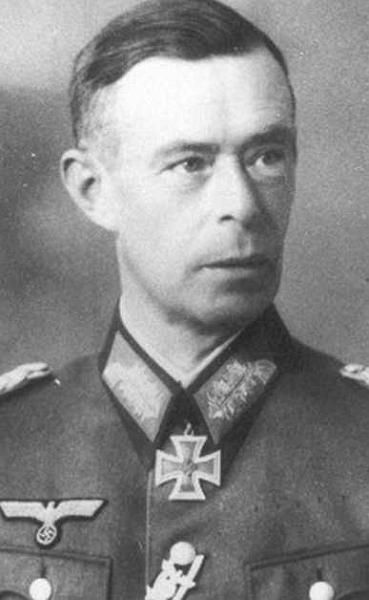 |
| Generalleutnant Erwin Rauch, Kommandeur der Division 6, August 1941. |
Propaganda: The German OKW issues a communique that summarizes operations to date. It announces that the Wehrmacht has inflicted "annihilating blows unique in history." These include taking 895,000 prisoners and destroying or capturing 10,388 guns, 13,146 tanks, and 9,082 aircraft. These figures may be overstated, but, even if taken at face value, they have not seriously impaired the Soviet Union's ability and willingness to resist.
German/Romanian Relations: Romanian dictator (his title is "
Conducator") Ion Antonescu attends the noon briefing at Army Group South headquarters along with Adolf Hitler. The latter confers upon Antonescu the Knight's Cross for his troops' performance to date.
US/Japanese Relations: Negotiations continue in deep secrecy between the two countries as Ambassador Nomura submits a new proposal from Tokyo to Secretary Hull. After the Americans turn down some offers of concessions in exchange for the lifting of sanctions, the Japanese propose a meeting between President Roosevelt and Prime Minister Konoye. The Americans do not immediately reject this, but President Roosevelt secretly is otherwise engaged at the moment in Canada.
Echoing similar statements today across the Atlantic by British Foreign Secretary Anthony Eden, Secretary Cordell Hill also says that any Japanese intrusion into Thailand would create a crisis in US/Japanese relations.
Anglo/Iranian/Thai Relations: In the House of Commons, British Foreign Secretary Anthony Eden announces that he has made a diplomatic protest with the Iranian government concerning German "tourists" in the country. He also openly warns Japan from invading or otherwise taking over Thailand, which he says would be "of immediate concern" to the British government. In fact, the Japanese have recently made a secret deal with the Thai government to fund continued trade relations between the two countries in order to evade the Anglo/US/Dutch banking sanctions. Thus, Japan at this time benefits from Thailand remaining a sovereign nation with access to international markets.
 |
| HMAS Perth's ship's company in Fremantle, 6 August 1941. |
Polish Military: Polish General Władysław Anders, recently released from the Lubyanka prison in Moscow, is appointed Commander-in-Chief of the Polish Army being re-formed from Soviet POWs in the USSR. This is pursuant to the Sikorski-Maisky agreement signed in London on 30 July 1941.
Soviet Military: The Red Army hands out the first two "Hero of the Soviet Union" awards to detachment commanders Pavlovskiy and Bumazhkov.
British Military: The first Bell P-39 Aircobra arrives in the United Kingdom. While destined for RAF No. 601 Squadron, trials of this new plane are begun by the Air Fighting Development Unit at Duxford. The British quickly find the plane inadequate for combat.
 |
| USS Alamac being unloaded at Reykjavik, 6 August 1941. |
US Military: President Roosevelt signs an executive order transferring the US Coast Guard's Honolulu District from the Treasury Department to the US Navy.
USN Task Force 16 (Rear Admiral William R. Monroe), led by the aircraft carrier USS Wasp and the battleship USS Mississippi, arrives at Reykjavik, Iceland. The flotilla brings 30 P-40Cs and three Stearman PT-13 Kaydets of the 33rd Pursuit Squadron to be based ashore for local defense. It also brings Catalina flying boats for patrol duties with VP-73 and VP-74. Transport American Legion, stores ship Mizar, and freighter Alamac bring troops and supplies.
Heavy cruisers USS Northampton (CA-26) and Salt Lake City (CA-25) continue their goodwill visit at Brisbane, Australia.
Forest land is cleared in North Carolina that will become Marine Corps Air Station Cherry Point.
Japanese Military: The Imperial Navy requisitions 8360-ton freighter Sanyo Maru. The IJN begins converting it to a seaplane carrier/tender. Among its modifications are the addition of a catapult, two 150-mm/45 cal single-mount guns, and two Type 93 13-mm single-mount machine guns. The IJN also requisitions 6795-ton salvage ship Yamabiko Maru.
Following up on recent decisions taken to not attack the Soviet Union, Tokyo instructs the Kwantung Army to avoid any border incidents with the Red Army.
 |
| Home of Finnish sniper Simo Häyhä. The Soviets had built bunkers and underground tunnel on the property. Rautjärvi, August 6, 1941 (SA-Kuva). |
British Government: King George VI and Queen Elizabeth visit Hull.
Holocaust: The Croatian Ustaše under Ivan Jovanović (known as "Blacky") perpetrate the Prebilovci massacre. The Croatian paramilitary group takes around women and children from the village of Prebilovci, Herzegovina and throws them into the Golubinka pit, near Šurmanci, to their deaths. This is just the beginning of killings at Prebilovici, as 820 of 1000 inhabitants ultimately are killed during the summer. The killings also extend into nearby communities with additional thousands killed. Those killing the villagers are their fellow villagers, with the victims tending to be Serbs.
Belgian Homefront: The Legion Vlaandern (Flanders Legion) is established. It is a collaborationist unit.
American Homefront: Pitcher Al Benton of the Detroit Tigers becomes the only player to have two sacrifice bunts in the same inning, against the Cleveland Indians - something that has not been equaled as of 2018. Benton serves in the US Navy in 1943 and 1944, then resumes his career with the Tigers.
Future History: Lyle Arnold Berman is born in Minneapolis, Minnesota. He becomes a top executive at companies such as the Rainforest Cafe but is better known as a world-class poker player. Berman has won 3 World Series of Poker (WSOP) bracelets in 1989, 1992, and 1994, and is a member of the Poker Hall of Fame.
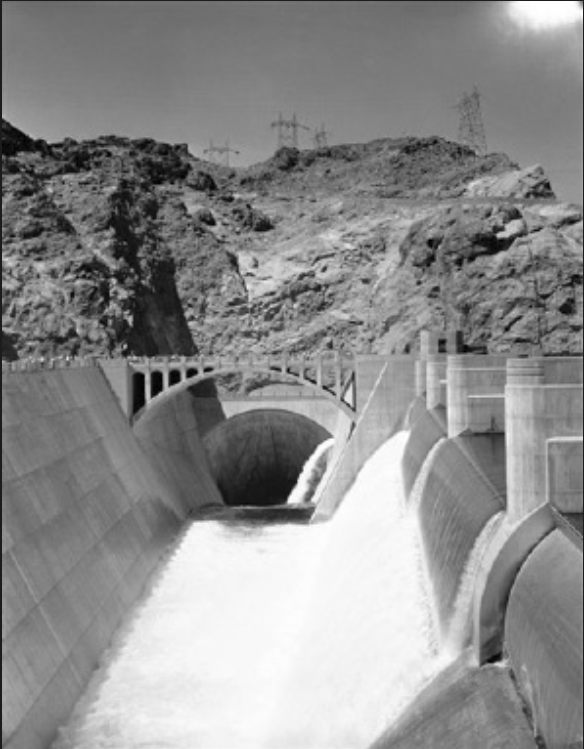 |
| Spectators watch from the bridge over spillway as Boulder Dam (Hoover Dam) overflows for the first time, August 6, 1941, and pours 15,000 cubic feet per minute from record-level of Lake Mead into Colorado River behind the dam. Spillway leads into tunnel 50 feet in diameter and then 2200 feet to river level below where water bursts out in a great jet. At the Dam, Lake Mead had reached a level of 590 feet and contained more than 10,000,000,000,000 gallons of water. (AP Photo). |
August 1941
August 1, 1941: More Executions on CreteAugust 2, 1941: Uman Encirclement ClosesAugust 3, 1941: Bishop von Galen Denounces EuthanasiaAugust 4, 1941: Hitler at the FrontAugust 5, 1941: Soviets Surrender at Smolensk August 6, 1941: U-Boats in the ArcticAugust 7, 1941: Soviets Bomb BerlinAugust 8, 1941: Uman Pocket CapturedAugust 9, 1941: Atlantic Conference at Placentia BayAugust 10, 1941: Soviet Bombers Mauled Over BerlinAugust 11, 1941: Rita Hayworth in LifeAugust 12, 1941: Atlantic Charter AnnouncedAugust 13, 1941: The Soybean CarAugust 14, 1941: The Anders Army FormedAugust 15, 1941: Himmler at MinskAugust 16, 1941: Stalin's Order No. 270August 17, 1941: Germans in NovgorodAugust 18, 1941: Lili MarleenAugust 19, 1941: Convoy OG-71 DestructionAugust 20, 1941: Siege of Leningrad BeginsAugust 21, 1941: Stalin EnragedAugust 22, 1941: Germans Take CherkassyAugust 23, 1941: Go to KievAugust 24, 1941: Finns Surround ViipuriAugust 25, 1941: Iran InvadedAugust 26, 1941: The Bridge Over the DesnaAugust 27, 1941: Soviets Evacuate TallinnAugust 28, 1941: Evacuating Soviets SavagedAugust 29, 1941: Finns take ViipuriAugust 30, 1941: Operation AcidAugust 31, 1941: Mannerheim Says No2020







